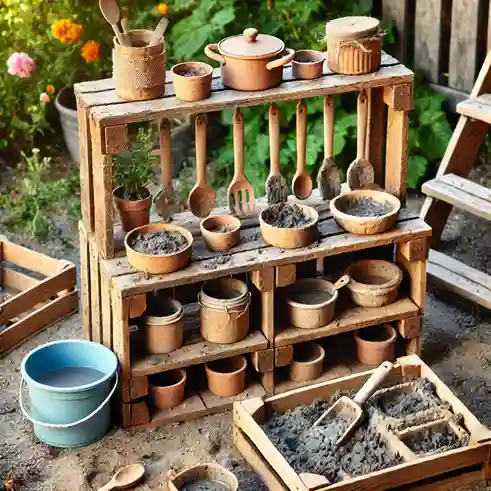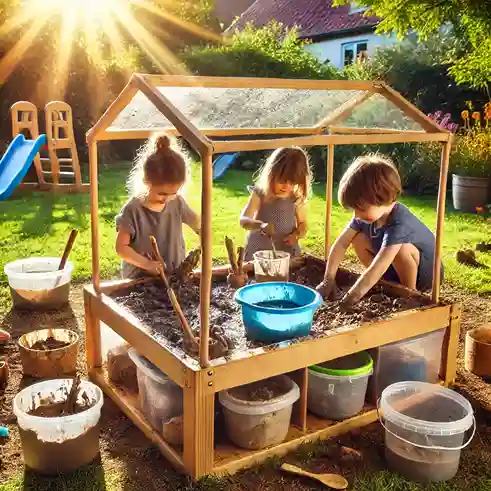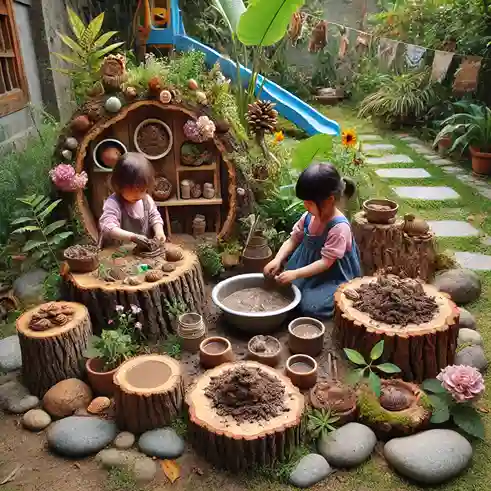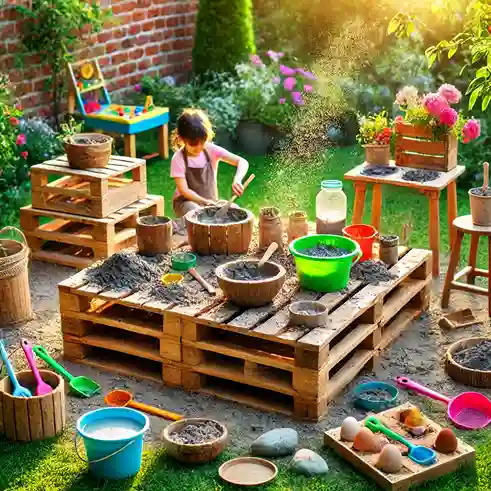Introduction to Outdoor Mud Kitchens
An outdoor mud kitchen DIY project is the perfect way to merge creativity, play, and learning for your little ones. A mud kitchen is basically a simple outdoor play setting in which the children may engage in imagination play while preparing food with natural products such as mud, sand, and water. These fun kitchens can be as elaborate or simple as you desire, making it an excellent DIY project for whatever outdoor space you may have, regardless of size.
In the recent years, Outdoor Mud Kitchen DIY have been especially popular as more and more parents realize the worth of their children’s outdoor play and hands-on learning. Such outdoor kitchens encourage some creativity but also promote sensory play rich in nature. More free play kids engage with this type, the more opportunities open up before them to discover the world that nature presents. Playing in the Outdoor Mud Kitchen DIY is not playing for fun, but growth and learning-instilling the ability to make an imprint that will last for years.
Clearly, it can be modified for any garden, backyard, or outdoor area. The materials will hardly cost that amount of money; for some pallets, a few reclaimed material, and probably some bricks or blocks you can have your Outdoor Mud Kitchen DIY ready in no time. Recycled materials can be utilized, hence making it an eco-friendly plan. As you go through the step-by-step DIY guide below, you will soon learn how to build an adorable Outdoor Mud Kitchen DIY for your tiny little ones.
This blog takes you through five spectacular Outdoor Mud Kitchen DIY ideas that are fun for kids, however budget-friendly and easy to create. Whether you are an experienced DIY enthusiast or just starting, these ideas will let you craft a unique play space outdoors that your kids will love. Let’s get started.
Benefits of Outdoor Play and Outdoor Mud Kitchen DIY
Outdoor play among little children is very valuable and indispensable to their daily lives, especially if a space is specifically set aside for it, like an Outdoor Mud Kitchen DIY. Available research indicates that children who play outside have physical, emotional, and cognitive benefits miles ahead of those in a playground.
Physical Benefits
Playing outdoors encourages kids to get around, aids in developing essential motor skills. Digging in the dirt, pouring water, and mixing materials all involve some physical coordination that enhances their muscle development. Children are naturally more active and energetic in outdoor environments, thereby promoting better health and fitness. Specifically, Outdoor Mud Kitchen DIY exemplify hands-on play that strengthens both fine motor skills, which involves using small muscles, like in their hands, and gross motor skills, which involves larger muscles, such as the legs and arms.
Maintaining regular outdoor playtime will also reduce the likelihood of obesity in children since physical activity is promoted among kids, furthering their well-being. Vitamin D intake is also increased through exposure to nature, which is crucial for the growth of developing kids’ bones. According to studies, kids who spend more time outdoors will typically develop healthier lifestyles and are less likely to acquire conditions associated with a sedentary lifestyle, like obesity and posture problems.
Cognitive Development and Problem Solving
Children who play in an Outdoor Mud Kitchen DIY are always deciding which new recipe to make, trying out a new “recipe,” or making something work. Such imaginative play promotes critical thinking and creativity. Such questions as “How much water will I have to add to my ‘mud pancakes’ so that they turn out just right?” help develop basic math and science skills.
Children will experiment with cause and effect. For example, “what happens when I add more water?” or “how do I do that and make this mud thicker?” This type of experimentation puts a fundament to the early age of learning in STEM. They start also to realize the measurements and proportions as they mix the materials in the containers.

Imagination and Social Development
Outdoor Mud Kitchen DIY are more than a playground; it is a stage for storytelling and role-playing. The children pretend to be chefs, invent their recipes, or unite with other kids for some cooperative play. This kind of interaction builds social skills in children, improves communication, and grows this feeling of teamwork within them.
Children become immersed in operating a “mud pie bakery” or creating a “soup of leaves.” These plays are their stories and roles, stimulating their brains and the development of creativity. In the presence of a sibling or friends, these children also acquire cooperative and negotiation skills. These role-play experiences provide them with very foundational aspects to help little ones develop empathy, communication, and emotional intelligence.
Sensory Play and Connection with Nature
Sensory play is quite essential for preschoolers because this helps the children in developing their sense experiences and improves brain development. It enables the child to go closer to nature by touching mud, feeling water, and rubbing leaves or sand between his hands. Similarly, Outdoor Mud Kitchen DIY cultivate love for the outdoors and nature and teach children to appreciate the existing material.
Mud, leaves, sand, water, for example, can be played with – so very sensory rich and calming. Children often find moments of delight in squishing, stirring, and manipulating materials. For those children with sensory processing issues, this sort of sensory input really helps them to become comfortable with the different textures and sensations that exist.
It is also a playful product, but its use acts as an undirective learning tool to introduce ecophysiological principles. Children discover elements, weather, soil, plants, and the cycle of water in their games, so play could be an educational resource with a hidden methodology.
Essential tools and materials to create DIY mud kitchens
Before setting up your Outdoor Mud Kitchen DIY, collect all the necessary materials and tools. The best thing about building a Outdoor Mud Kitchen DIY is that it doesn’t make use of lavish things. Many things can be recycled or repurposed from items you already have at home.
Here’s some basic stuff you’ll need in terms of tools and materials to get you started:
Basic Materials:
Wooden pallets or planks. These are often used for the design of the bottom base, counter, and shelves. What’s more, they’re among the most sustainable resources you can work with since they’re usually free or cheap.
Old kitchen utensils: Scour your kitchen for those old spoons, ladles, pots, and pans that do not seem to have a place anymore. These will work great for them to play with.
Buckets and containers: Small and large containers where water, mud, or other materials can be placed in. You can use old plastic containers, flower pots, or tin cans.
Water source: The water source can be a garden hose or just a water jug. With a little more budget, you can have a small water pump just to up the fun level.
Natural Material: Stones, sand, leaves, and so much more; the more your kids can use different textures and consistencies that are made up of natural materials.
Tools and Materials
Hammer and nails
Screwdriver and screws: Screws are used for stability, and securing shelves and other units attached as opposed to nails.
Measuring Tape: Every such kitchen requirements alignment, so measuring tape is essential.
Sandpaper: In order to smooth off any rough edges on the wooden pieces, so that the kitchen will be safe enough for little hands.
Saw: If you want pieces of wood that have been cut to size then you need to cut the wood to the required size.
Optional Extras:
Paint and sealant: If you want to decorate or weatherproof your Outdoor Mud Kitchen DIY, you can use non-toxic paints. A waterproof sealant protects wooden surfaces from damage caused by water.
Chalkboard: Attach a small chalkboard on the side of the Outdoor Mud Kitchen DIY where kids can post up their recipes or daily specials.
Appliances: Parents also reuse some old toasters, kettles, or other gadgets for added realism. Of course, these should be very well cleaned and made safe for outdoor play.
This is where the fun and exciting part begins! It speaks of five different DIY designs that will work well for an Outdoor Mud Kitchen DIY: rustic wood versions, modern creations, and everything in between. Whether you are good with your hands or not matters little; there’s a mud kitchen idea waiting for everyone.

Outdoor Mud Kitchen DIY Using Rustic Wood
Rustic Wood Outdoor Mud Kitchen DIY is one of the more popular DIY ideas for an Outdoor Mud Kitchen DIY. You will have a robust, almost-natural-looking play kitchen that survives the harsh elements of the outdoors.
Materials:
Used wooden pallets or planks
Nails and screws
Old kitchen utensils and pots
Steps to Create:
Create a simple wooden frame with the pallets. This will help you make the base and counter of the Outdoor Mud Kitchen DIY.
Attach a wooden plank to the back as a splash board and hang some old utensils for easy access.
Add some containers or bowls in designated spots where kids can mix mud and water.
This can be customized by hanging a chalkboard for kids to jot down their recipes or play restaurant games.
This is quite quaint and indestructible hence perfect for families who want something that will get mixed up with their garden environment.
Recycled Pallet Outdoor Mud Kitchen DIY
The second eco-friendly way of creating a Outdoor Mud Kitchen DIY is by utilizing old or reused pallets for a Recycled Pallet Outdoor Mud Kitchen DIY. Recycled pallets can come free, hence making it an excellent material for a DIY project.
Stuff needed for the project:
Wooden Pallet
Sandpaper
Old kitchen utensils
Waterproof sealant (optional for longevity)
How to build it
Choose two pallets, clean them, and sand the rough edges for safety.
Stack the pallets in a stable manner and attach using screws or nails.
You can use more pallets to serve as shelving or countertops.
You can add hooks or pegs to hang pots and pans or an apron.
This Outdoor Mud Kitchen DIY is cost-effective and educates children in the benefits of recycling and reusing material. It also adds an eco-friendly touch to your outdoor space.

Mobile Outdoor Mud Kitchen DIY in Plastic Containers
A Portable Outdoor Mud Kitchen DIY is the solution for homes with little outdoor space or families that desire a kitchen they could easily move. It is created using lightweight plastic containers and is extremely easy to assemble.
Huge plastic containers or tubs
Smaller containers and trays
Old kitchen utensils
Instructions to Make:
Arrange a couple of large plastic containers as a base for the kitchen. It can be used to mix mud or hold water.
Smaller containers on top of that for kids to organize the “ingredients” like leaves, stones and sticks.
Lightweight trays or shelves that could be clamped or stacked should be included in order for utensils and mud to be easily reached.
It also can be moved from place to place around your outdoor space because the play areas may vary.
This type of Outdoor Mud Kitchen DIY is perfect for apartments or any smaller outdoor spaces as it could easily be stored when not in use. You could even bring it indoors and get all messy on a drizzly day. It’s such a versatile option.
The Nature-Inspired Outdoor Mud Kitchen DIY
For nature-loving families, a Nature-Inspired Outdoor Mud Kitchen DIY really lets you bring natural elements directly into the design. This Outdoor Mud Kitchen DIY is environmentally conscious because it focuses on the use of materials from the environment to allow for a fully organic play space.
Materials:
Rocks, stones, and logs
Natural clay or soil
Tree branches for shelving
Steps in Creating:
Put large stones or logs together as the framework of the kitchen. These will be the base or counter area.
Use branches from a tree or driftwood to create shelves for a nature-inspired rustic look.
Build a collection of natural materials, such as leaves, pinecones, and sand, for kids to use like “recipes” for mud play.
This is a seamlessly integrating Outdoor Mud Kitchen DIY within natural landscapes. The advantage of this project will be a great addition to the garden or forested backyard for the kids’ outdoors experience. This project teaches the children how to work with nature’s bounty, teaching respect and appreciation for what’s there.
Fancy Customizable Outdoor Mud Kitchen DIY
This is a more refined and customizable version. The Fancy Customizable Outdoor Mud Kitchen DIY allows you to customize it further with running water, paint, and other decorative features.
Materials:
High-quality wood or plastic
Paint and waterproofing finish
Kitchen sink- either repurposed or toy version
Water pump or hose attachment
Steps to Create:
Start with a good strong wood frame or use plastic that is robust, which will form the base of your kitchen.
Install a manually passed-down sink, such as the kitchen sink in an older kitchen or a toy sink, so children really get into washing dishes and mixing mud.
Painter the entire kitchen in bright colors. Install hooks for hanging utensils, or shelves to increase space.
Add small amounts of running water, maybe using some low-pressure water pump or hose, for an additional layer of fun.
It’s the most elaborate Outdoor Mud Kitchen DIY on our list that allows you to get creative with features and design. You can even add weatherproof cushions or storage boxes for outdoor toys to maximize the usability of the space.
How to Encourage Learning Through Play in a Outdoor Mud Kitchen DIY
Mud kitchens are intrinsically playful. However, they are also very educational. Read on for ideas to help you learn through play with a homemade Outdoor Mud Kitchen DIY:
- Introducing Math Skills
outdoor mud kitchen diy offer an organic playground in which to teach the math. They can count, measure, and divide as the case may be. Consider measuring some liquids with your child. Ask your child to retrieve a few balls using the appropriate measurement. Then ask your child to distinguish between the length of several objects.
“How many cups of water will be required to fill this bucket?”
“How do you quantitatively measure mud into equal portions for two ‘pies’?”
- Encourage Curiosity in Science
The Outdoor Mud Kitchen DIY is your mini-lab that fosters scientific discoveries. Encourage your children to observe how different materials mix and respond. For instance:
What does the sand do when you add water?
What happens if you add leaves to mud?
How do you make mud more or less lumpy?
This kind of discovery fosters a style of curiosity and scientific mentality.
- Enhance Your Vocabulary and Oral Communication Ability
Children acquire the ability to communicate simply through role-play. Teach them to narrate what they have produced, name what they are preparing, or describe their cooking process. This enhances vocabulary and enhances the art of narration.
- Instil Sense of Responsibility and Self-Autonomy.
Responsible kids feel independent while handling their Outdoor Mud Kitchen DIY, which may be in cleanliness up after play or organizing tools, but at all stages, developing life skills, in the long run, it also makes the children take ownership of their play space.
More Creative Outdoor Mud Kitchen DIY Games and Activities
Outdoor Mud Kitchen DIY do not have to only be used as a source for play food. Here are a few more creative ways to support engaging your kids in their outdoor mud kitchen DIY setup:
- Mud Pie Bake-Off Competition
Create a bakery in your Outdoor Mud Kitchen DIY and have a “mud pie baking competition.” Ask the neighbors or do it as a family competition. Encourage them to get creative about your use of available materials, such as mud, leaves, stones, flowers, and so on. The winner receives a prize: his or her very own chef’s hat.
- Nature Art
Encourage the kids to do “art” using mud and other natural materials. They can use the leaves and twigs to act as paintbrushes, or a “paint” that uses flower petals as color and decorations on their mud cakes, or even sculpting a simple clay or mud sculpture.
- Science Experiments
Set up simple science experiments in your Outdoor Mud Kitchen DIY, such as:
Test what floats and what sinks in a bucket of water.
Experiment with different water-to-mud ratios to find what provides the most suitable consistency for construction.
Create a mud volcano by mixing baking soda and vinegar in a mud mixture!
- Story Time in the Outdoor Mud Kitchen DIY
Use the Outdoor Mud Kitchen DIY as a backdrop for storytelling. Children can tell stories about what they are cooking or pretend that they live in another time period or place, which would offer dramatic play.
- Mud Kitchen Farmers Market
You can extend your mud kitchen into a pretend “farmers market.” Encourage your child to “sell” their creations. This will help them develop such skills as social, money exchange, and even simple math!
Tips for Maintaining Your Mud Kitchen
Having built an outdoor mud kitchen DIY project is a great beginning. But proper maintenance will ensure its longevity and safety. Here are the tips:
Cleaning utensils and surfaces regularly: It is because mud and water are the main protagonists, therefore the utensils and the surfaces have to be cleaned on a regular basis to avoid raising mold and bacteria.
Weatherproof: Use a waterproof sealant on wooden parts of the mud kitchen to prevent it from getting damaged due to rain and moisture.
Storage: Once you have put away the kitchen, most specifically during extreme conditions, ensure that they are covered to prolong their lifespan.
Supervision: Though the mud kitchen is very safe, children should be watched so as to use the space responsibly.
Inspect for Wear and Tear: From time to time check the mud kitchen and its parts to ensure that there are no loose screws, splintered wood among other things that may be a risk during playing.
FAQs
Q1: What is a good age for a child to start playing in a mud kitchen?
A: Mud kitchens are suitable for kids 2 years old upwards, but kids of a younger age need to be constantly supervised.
Q2: I can buy the mud kitchen ready made, right?
A: Yes, many parents use store-made mud kitchens, but when you make a DIY, it lets you modify and is most likely to be more economical.
Q3: How much floor space do I need for a mud kitchen?
A: For instance, a small outdoor space, or even portable designs, on the balconies or small yard can have a mud kitchen. The available space allows you to determine its size.
Q4: What kinds of materials are safe for a mud kitchen?
A: Use non-toxic paints and decorations for the mud kitchen. Also, you can use natural materials such as wood and stone because these are child-friendly.
Q5: Can I add real water to the mud kitchen?
A: Of course! Many mud kitchens include a source of water, perhaps a garden hose or a small water pump, which really does add to the fun and learning of it. Do keep an eye on water usage and ensure that this area is slip free and safe and sound.
Conclusion
This mud kitchen DIY is full of fun for the kids and will enhance their time spent playing. Whichever you prefer-the simple recycled pallet kitchen or the nature-inspired more detailed version-these get-to-play outdoor kitchens offer endless imaginative play, sensory explorations, and outdoor fun. From five ideas to materials, it would not be tough to turn your garden into a creative play space.
So, what’s the wait for? Create your own outdoor mud kitchen today and let your kids reap the fruit of creative outdoors play!

